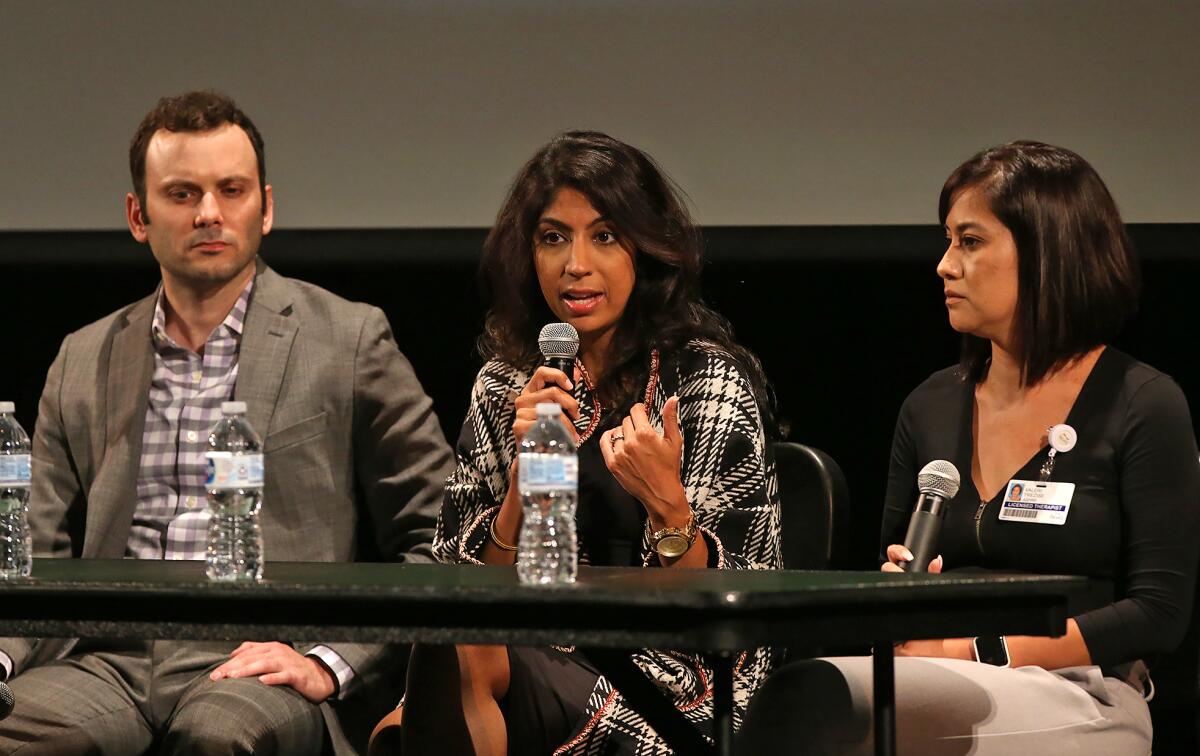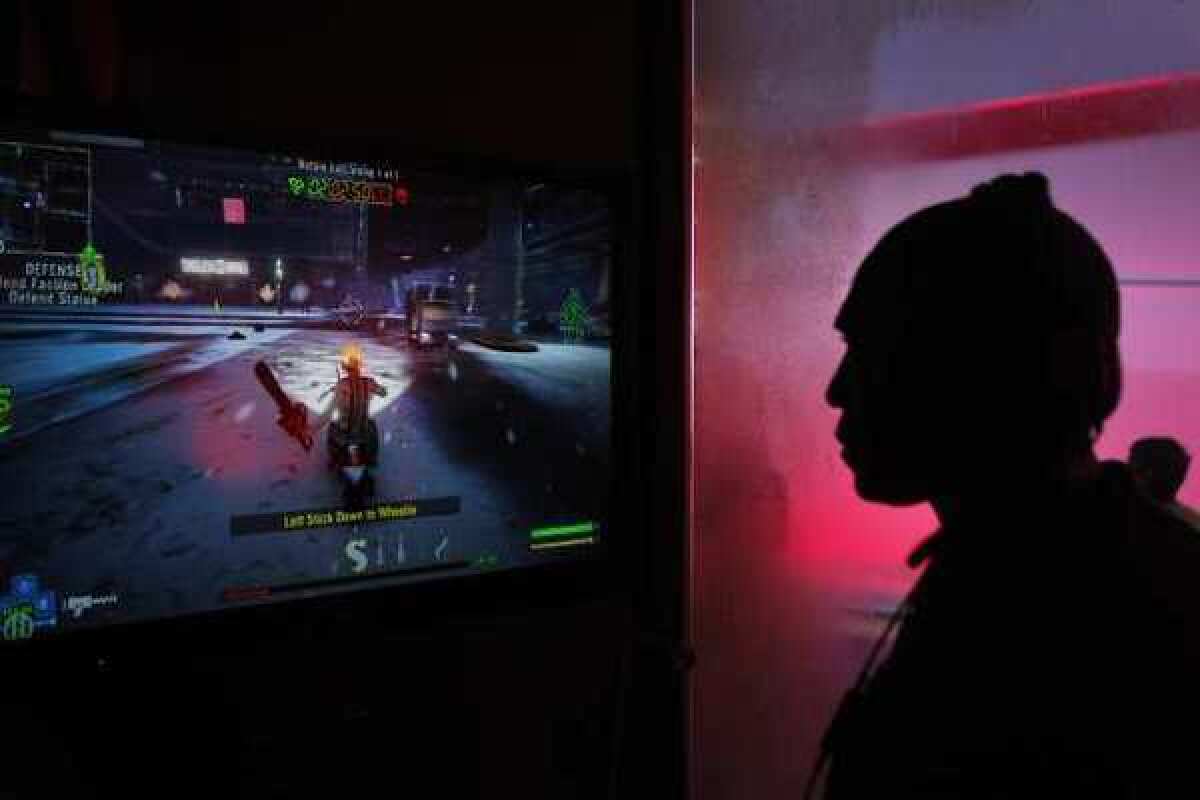Capistrano Valley High School hosts panel for parents concerned about teens’ gaming and social media habits

- Share via
By age 21, the average young person spends 10,000 hours playing video games, roughly the same amount of time they spend for all of middle school and high school, said Dr. Sina Safahieh, a child psychiatrist who oversees an Orange County program specializing in mental health treatment of adolescents.
At a Sept. 11 panel discussion at Capistrano Valley High School in Mission Viejo titled “Gaming, Social Media and Mental Wellness,” Safahieh, along with other mental health clinicians, spoke to parents about the consequences of overuse of technology by teens and adolescents.
The presentation was the first in a speaker series being hosted by Hoag Hospital and the Capistrano Unified School District titled “Helping Teens and Families Navigate Mental Health and Wellness.”
Safahieh said the gaming industry generates nearly $1.4 billion per year in revenue, which is more than the NFL, NBA, MLB and NHL combined.
More people watched “League of Legends” than the NBA finals, said Safahieh, who also oversees Hoag’s ASPIRE program, an acronym for “After School Program for Interventions and Resiliency Education.”
“It’s basically the major form of entertainment in this country,” Safahieh said. “This is a full-time job, and they are not getting paid. They’re actually paying for this job, and they are not only paying with cash money, they are paying with their future, unfortunately.”

The World Health Organization, in May 2019, classified gaming addiction as a diagnosable disorder, and the Diagnostic Statistical Manual, the statistical bible used by mental health professionals, Safahieh said, identified gaming addiction as a psychiatric condition warranting more research.
“Ultimately, this comes down to a form of escapism and avoidance,” Safahieh said.
Safahieh spoke of an adolescent patient who attempted suicide by jumping out a window after his father took away his video games.
“It was a catastrophic issue,” the doctor said. “That’s just one example of how egregious [the addiction] can get. These kids are playing for 30 or 40 hours back to back, without stopping, without eating, without standing, without urinating.”
Children who spend too much time engaged in electronic media are more likely to read and exercise less, be overweight, have lower grades and get less sleep.
But not only is gaming here to stay, the technology will likely get more advanced throughout the next decade, said Prerna Rao, clinical program manager for ASPIRE and a licensed marriage and family therapist.
Rao compared parents’ concerns surrounding the impact of technology on their children to parents’ fears after the advent of television.
“But it’s sort of on steroids at this point because we are seeing the negative effects that it has,” Rao said.
Excessive gaming and focus on social media can cause psychological effects such as irritability, depression, isolation and anxiety.
Citing the 2018 Orange County Conditions of Children Report published by the Orange County Children’s Partnership, Safahieh said Orange County has seen a 29% spike in teen suicides over the past decade — higher than the state’s 22% increase during the same period.
Ten teen suicides have been reported in the county in 2019, Safahieh said, already higher than the 2018 total of seven.
Additionally, for each death by suicide, there are 10 hospitalizations for suicide attempts, the doctor said.

Parents staying educated and engaged with their children’s technology use is key in staving off potential issues, said Valeri Trezise, a licenced marriage and family therapist with ASPIRE.
“One thing we see a lot of with adolescents is that they are using social media as their main form of communication and socializing with their peers and so they are not getting the extracurricular activities outside of the house,” Trezise said. “We are the parents. We are the adults and we have to lead by example.”
Requiring children to take care of their responsibilities such as homework and chores before being allowed to play video games should be standard practice, Rao said.
The clinicians also encouraged parents to insist on having the passwords to their kids’ social media accounts and to buy software that monitors their use of technology.
“I think a lot of the times, we get parents who are afraid to be parents,” Rao said. “Will you get a lot of flak for it? Yes you will. But in the long run you have to think about the impact it’s having on your teen at the moment and what they will look like when they turn 18 ... because these [technologies] are having long-term impacts on these teens.”
The next presentation, “Identifying Substance Abuse Disorders and Vaping Dangers” is scheduled for 6 to 8 p.m. Nov. 13 from 6 to 8 p.m. at Aliso Niguel High School, 28000 Wolverine Way, Aliso Viejo. Dr. Steven Ey, chief of service, Hoag Addiction Treatment Centers will be the featured speaker. For more information, go to cusdinsider.org and hoag.org/ASPIRE.http://www.hoag.org/ASPIRE
All the latest on Orange County from Orange County.
Get our free TimesOC newsletter.
You may occasionally receive promotional content from the Daily Pilot.



